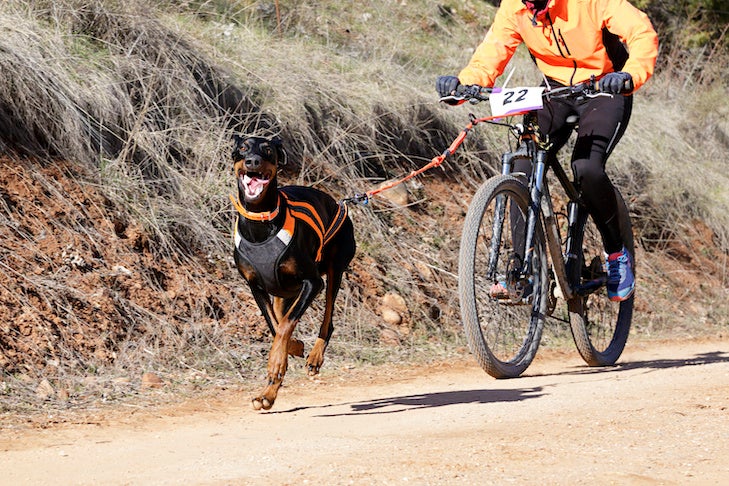
If you and your dog are adventurous and fit, and your dog loves to run, then the up and coming sport of bikejoring might be a good fit. Already well-established in Europe, dog-powered mountain biking is growing in popularity in the U.S too.
In its infancy, sled dog racers created bikejoring. It was an ideal way to train and maintain their dogs’ fitness levels outside of the snowy winter months. Gradually, the pursuit caught on with a wider group of enthusiasts, and competitive bikejoring began to take shape.
Bikejoring enthusiast Sarah Kassing is a veterinarian and leader of the Arizona Chapter of Canicross USA. Alongside her husband, Brad, Kassing developed an interest in the sport a few years back. She describes how, in the last decade or so, the sport has gained traction. Race events are growing at a local, nationwide, and international level. In 2019, Sarah and Brad represented the United States as elite Bikejoring and Canicross competitors at the Dryland World Championships in Sweden. She explained that, even on a less competitive level, “it’s such a beneficial way for people to enjoy active time with their dogs”.
How Does Bikejoring Work?
In the competitive world of Bikejoring, a team consists of the rider along with one or two dogs. The dogs will pull out in front of the bike. Competitions take place on off-road, soft dirt trails that are relatively flat and free from problematic obstacles. Most races involve individual time trials. These allow the competitors to negotiate the course without worrying about others in their way. This is a fast-paced sport, and not for the faint-hearted!
What Gear Do You Need to Bikejor?
If you already have a mountain bike, you’ll have saved yourself a significant initial outlay. Given the types of trails you’ll be riding on, you don’t need a bike with flashy suspension. It will, however, need reliable brakes and a solid frame. After all, it could have two strong dogs attached to it!
Your dog will need a well-fitting harness, specifically designed for bikejoring. This ensures the appropriate distribution of strain across their body. When running or cycling with your dog, even if it’s not competitively, never attach the leash directly to their collar. This puts way too much direct pressure on the throat. You’ll also need a rigid attachment for the bike, which helps prevent the leash from tangling in the wheels, and a long-length bungee leash.
It’s not just about the gear either. As Kassing explains, “It can be tricky to find appropriate and accommodating trails, as many are multi-use. You need to be safe, polite and considerate of other trail users.” Ensuring your dog is well-behaved and under control will minimize any problems.
What Dogs are Suited to Bikejoring?
Dogs that love running, and readily pull out front, make enthusiastic bikejoring athletes. They might already be canicross participants. Your dog should be fit, powerful, and confident. Attaching a nervous or reactive dog to a fast-moving bike would be a recipe for disaster!
Dogs that excel at mushing, like Siberian Huskies and other Northern breeds, are obvious candidates for the sport. There are, however, a wide range of bigger dogs that take part in club rides. Kassing explains that her dogs were bred specifically to excel in dryland racing. They’re “very athletic, with lots of endurance and enthusiasm, and their natural sled dog skills shine through”. She also recognizes the benefits that her dogs get from the sport. “Bikejoring keeps my dogs physically active and mentally stimulated”, she says. “The improved blood flow of oxygen to the brain and the endorphins released are wonderful things for the mind and body. At home, my dogs aren’t bored; they feel satisfied and content.”
Before you get started, your dog should have a health check from your vet, and you should build up their fitness levels gradually. Fast-paced bikejoring isn’t recommended for puppies, with their soft growing bones, small breeds, and senior dogs with mobility problems. Even if your dog isn’t suited to this fast-paced, strength-related sport, it doesn’t mean they can’t join you on bike rides. You can get them used to traveling in a suitable bike carrier or running at the side of the bike at a slower pace.
What Training is Required to Bikejor?
“For dogs that don’t have that intense drive, but do enjoy running, it can initially be tricky to get them to want to stay in front”, says Kassing. “Finding others that are active in the sport can be immensely beneficial.” Initially, having another bikejoring team, or even just a runner in front, can ignite the instinctual desire to chase. This often motivates your dog to go ahead. Mastering consistent and encouraging commands is also vital for a successful bikejoring partnership. Your dog should, at least, understand commands for controlling their pace, and turning left, right, and straight on. The bond and trust shared with your dog will grow through your bikejoring journey.
I’d Like to Give Bikejoring a Try. Where Can I Find Out More?
If you can find a local club, you’ll get support and guidance from more experienced bikejoring enthusiasts. However, because the sport is still growing, you might not always be lucky enough to have an established club nearby. Kassing recommends networking with like-minded individuals on social media. Often canicross clubs will also have members that enjoy biking with their dogs too. You can find out more about the competitive side of things through the United States Federation of Sleddog Sports. In Arizona, Sarah and Brad also run the Trail Dog Association of Arizona. Their focus is on dryland and sled sports, but they also encourage backpacking with dogs. With a bit of encouragement and practice, you and your dog could soon be hurtling down a bike trail together, heading toward your first medal.
To explore more exciting news and information about outdoor sports and adventures, visit HOT NEWS DAY.